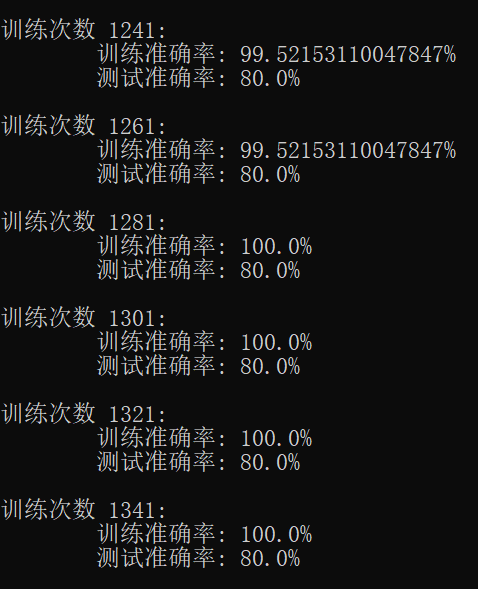作业 03 - 深层神经网络
深层神经网络
最重要的是要让整个过程向量化以加快运行速度,这里给出矩阵的大小.
假设一共有 $\mathrm{L}$ 层,$\mathrm{m}$ 个训练样本,每一层的节点数量为 $\mathrm{n[l]}$
$\mathrm{W[l] = (n[l], n[l - 1])}$, $\mathrm{b[l] = (n[l], 1)}$, $\mathrm{Z[l] = A[l] = (n[l], m)}$
正向传播公式
$\mathrm{Z[l] = W[l]A[l - 1] + b[l]}$, $\mathrm{A[l] = g(Z[l])}$
反向传播公式
注:在 $\mathrm{A[L]}$ 对 $\mathrm{Cost}$ 求导时没有算进 $\mathrm{\frac{1}{m}}$
根据后续的需要进行的除法.
$\mathrm{d(Z[l])=d(A[l]) * g[l]'(Z[l])}$
$\mathrm{d(W[l]) = \frac{1}{m} d(Z[l]) A[l - 1] ^{T}}$
$\mathrm{d(b[l]) = \frac{1}{m} np.sum(d(Z[l]), axis=1, keepdims=True)}$
$\mathrm{d(A[l - 1]) = W[l] ^T d(Z[l])}$
代码
这份代码里封装了 $\mathrm{ANNs}$ 函数,只需要输入每一层的节点数量,激活函数类型,程序就会根据训练数据学习.
最佳的参数需要自己一步一步去调,同时学习次数不宜过多防止过拟合的事情发生.
学习效果:

调用代码:
from inspect import Parameter import numpy as np import h5py import matplotlib.pyplot as plt from lr_utils import load_dataset from beta import ANNs, calculate train_x, train_y, test_x, test_y, classes = load_dataset() train_x = train_x.reshape(train_x.shape[0], -1).T / 255 test_x = test_x.reshape(test_x.shape[0], -1).T / 255 X , Y = train_x, train_y acti = ["ng", "relu", "relu", "relu", "sigmoid"] layer = [X.shape[0], 20, 20, 5, 1] ANNs(X, Y, test_x, test_y, layer, acti, 10000, 0.0075)
$\mathrm{ANNs}$ 代码
import numpy as np
import matplotlib.pyplot as plt
import h5py
def sigmoid(x):
return 1.0 / (1.0 + np.exp(-x))
def dsigmoid(y):
return y * (1 - y)
def relu(x):
return np.maximum(0.0, x)
def drelu(y):
return (y > 0).astype('int')
def tanh(x):
return (np.exp(x) - np.exp(-x)) / (np.exp(x) + np.exp(-x))
def dtanh(y):
return 1 - np.power(y, 2)
# 随机初始化 W, b 的值.
def initialize(layer_dims):
np.random.seed(2)
L = len(layer_dims)
parameters = {}
for l in range(1, L):
parameters["W" + str(l)] = np.random.randn(layer_dims[l], layer_dims[l - 1]) / np.sqrt(layer_dims[l - 1])
parameters["b" + str(l)] = np.random.randn(layer_dims[l], 1) * 0.01
return parameters
# 向前函数.
def linear_forward(A_prev, W, b):
"""
计算出导出的 z[l]
cashe[0] = A_prev
cashe[1] = W
cashe[2] = b
cashe 保存 (A_prev, W, b)
"""
z = np.dot(W, A_prev) + b
cashe = (A_prev, W, b)
return z, cashe
def forward(A_prev, W, b, activation_type):
"""
返回:
A[l]
g[l]'(z[l])
z[l]
linear_cashe
"""
z, linear_cashe = linear_forward(A_prev, W, b)
if activation_type == "sigmoid":
A_nex = sigmoid(z)
delta = dsigmoid(A_nex)
if activation_type == "relu":
A_nex = relu(z)
delta = drelu(A_nex)
if activation_type == "tanh":
A_nex = tanh(z)
delta = dtanh(A_nex)
return A_nex, delta, z, linear_cashe
def backward(dAL, delta, z, linear_cashe):
dZL = dAL * delta
dWL = (1 / dAL.shape[1]) * np.dot(dZL, linear_cashe[0].T)
dbL = (1 / dAL.shape[1]) * np.sum(dZL, axis = 1, keepdims = True)
dA_prev = np.dot(linear_cashe[1].T, dZL)
return dZL, dWL, dbL, dA_prev
def calculate(X, parameters, layer_type):
L = len(layer_type)
A = X
for i in range(1, L):
A = np.dot(parameters["W" + str(i)], A) + parameters["b" + str(i)]
if layer_type[i] == "sigmoid":
A = sigmoid(A)
if layer_type[i] == "relu":
A = relu(A)
if layer_type[i] == "tanh":
A = tanh(A)
return A
# 输入训练数据与测试数据方便监测学习过程.
def ANNs(X, Y, tx, ty, layer_dims,acti_type,steps = 1000, lr = 0.09):
parameters = initialize(layer_dims)
# data 用来存储数据
for i in range(steps):
A = X
L = len(layer_dims)
data = []
data.append(())
for l in range(1, L):
A_nex,delta,z,linear_cashe = forward(A, parameters["W"+str(l)], parameters["b"+str(l)], acti_type[l])
data.append((A_nex, delta, z, linear_cashe))
A = A_nex
dAL = -(Y/(A + 1e-9)) + (1 - Y) / (1 - A + 1e-9)
for l in range(L - 1, 0, -1):
dZL, dWL, dbL, dA_prev = backward(dAL, data[l][1], data[l][2], data[l][3])
parameters["W" + str(l)] -= lr * dWL
parameters["b" + str(l)] -= lr * dbL
dAL = dA_prev
# 每隔 20 次输出正确率.
if i % 20 == 0:
cc = 0
z = (calculate(X, parameters, acti_type) >= 0.5).astype('int')
for j in range(Y.shape[1]):
if z[0][j] == Y[0][j]:
cc = cc + 1
z = (calculate(tx, parameters, acti_type) >= 0.5).astype('int')
pp = 0
for j in range(ty.shape[1]):
if z[0][j] == ty[0][j]:
pp = pp + 1
print("训练次数 " + str(i + 1) + ": ")
print(" 训练准确率: " + str(cc / Y.shape[1] * 100) + "%")
print(" 测试准确率: " + str(pp / ty.shape[1] * 100) + "%")
print("")
return parameters






 浙公网安备 33010602011771号
浙公网安备 33010602011771号